What is a Rook in Chess? Understanding Its Role & Power

Each player has six unique pieces in a game of chess, yet the rook is one of the most powerful. It has amazing movement mechanics to help you take control of the board and capture your opponent’s pieces - but what is a rook, and how do you use one?
Our guide will explain all, starting with a brief explanation of the rook and where it fits in a game of chess.
An Introduction to the Rook
Each player will have two rooks on their side of the board, positioned on the back row, with one on the far left and the other on the far right. Rooks are commonly depicted as castles in chess sets, which is why most players will refer to them by this name.
The term “rook” comes from an ancient game called Shatranj from the Middle East. It was popular in medieval times and is considered one of the earliest forms of chess that anyone can find. In Shatranj, there was a piece called the “Ratha,” which translates to “chariot.” It moved like a modern-day rook, and when the game arrived in Persia, the locals couldn’t pronounce the name and called it a “Rukh” instead.
From here, Rukh turned into Rook, which is where the name comes from.
How the Rook Moves
The rook has some of the most powerful and diverse movements in a game of chess - but also some of the easiest movements to understand. It’s not like a knight, which requires lots of thinking and moving in different directions.
Instead, a rook can move as follows:
- Any horizontal direction
- Any vertical direction
- As many spaces as you wish

As this image shows, the rook can move into any space on a horizontal or vertical axis. You can move it forward or backward, depending on the type of move you’re trying to make. You can’t move a rook if there’s a piece blocking it, as is the case at the start of the game.
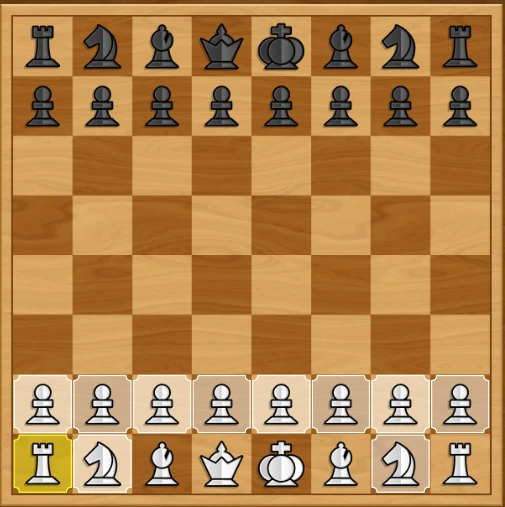
This image highlights the rook on the first term, and you can see there are no green spaces available because the pawn blocks its movement. Therefore, many players like to clear space for their castles/rooks as early as possible to bring them into the game.
One other key thing to note about a rook is that it can’t move diagonally. Diagonal movements are unique to bishops, queens, kings, and pawns that are about to capture other pieces.
How to Capture Pieces with a Rook
Capturing your opponent’s pieces is easy, as the rook does this in the same way that it moves. If there’s a piece on the same horizontal or vertical path as your rook, then you can remove it from the board by moving it to its place.
As a reminder, most captures in chess involve your piece taking the place of the piece it captures instead of filling in the space behind - as is the case in other board games like checkers. The only exception to this rule is the En Passant capture, but that’s unique to special situations involving pawns.
Here are a couple of images displaying how to capture pieces with your rook during a game:
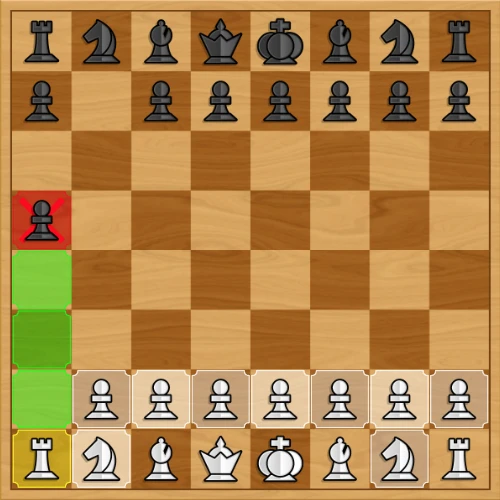
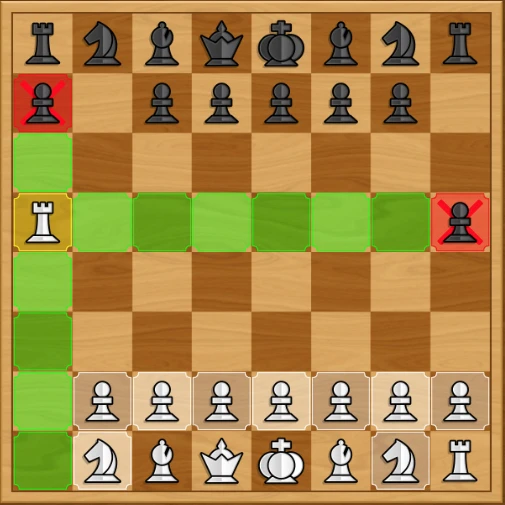
The left image demonstrates a typical vertical capture. You can move your rook to the red pawn’s place and remove it from the board. The right image shows how versatile a rook’s movement and capturing ability are. You could move your rook vertically to capture the pawn or move horizontally across the board to remove the other pawn.
You’re only allowed to capture one piece per turn - in truth, neither of the above moves makes a lot of sense. In both scenarios, you end up placing your rook ahead of your opponent’s rook on either side. It would mean you capture a pawn but lose a rook, which is not a good trade-off for you.
Unique Moves of the Rook
We mentioned En Passant earlier, which is a special move for pawns to make during a game of chess. It’s one of only three special chess moves - one of the others is called Castling, and it involves your rook.
Castling is arguably the most unique move in chess because it technically lets you make two moves in one go while also obliterating the rules of how your rook moves. The gist is that you move your King two spaces to the left or right and place your rook on the opposite side of it.
That might sound confusing when written down, so here’s a visual demonstration of what Castling entails:
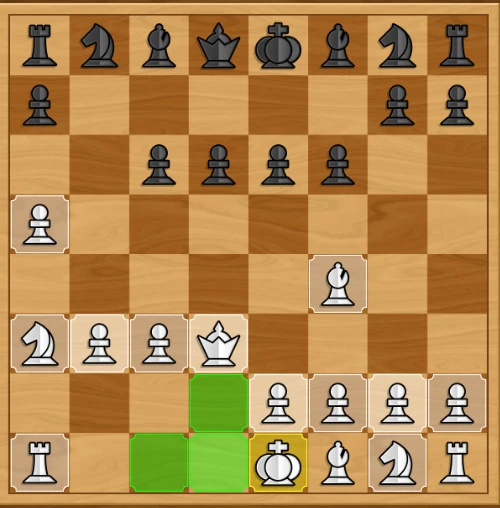
Looking at this image, you can see the King is highlighted in yellow and can move two spaces to the left. Normally, a King can only move one space in any direction, but it’s able to move two to the left because Castling is available.
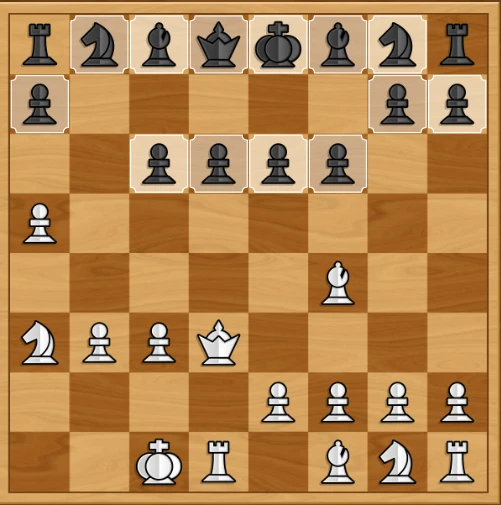
In the next image, you see the King moved two spaces to the left, and now the rook has jumped to the free space on its right. This is Castling - your rook can jump over as many spaces as it wants in this move, provided it lands in the space on the opposite side of where your King moved.
For example, if your King moves to the right, the rook would need to be in the adjacent spot on its left. The whole purpose of Castling is to offer some added protection to your King. It’s an excellent defensive move in many scenarios, though multiple stipulations must be met for Castling to be allowed.
- No pieces can be between your King and rook
- Both the King and the rook must not have made any moves beforehand
- You can’t use Castling to get out of a check
- You can’t castle if it moves your King into a check position
- You can’t castle if it means your King moves over a check position
Most of those rules are simple, though the last two may sound a bit confusing, so here’s a visual explanation:
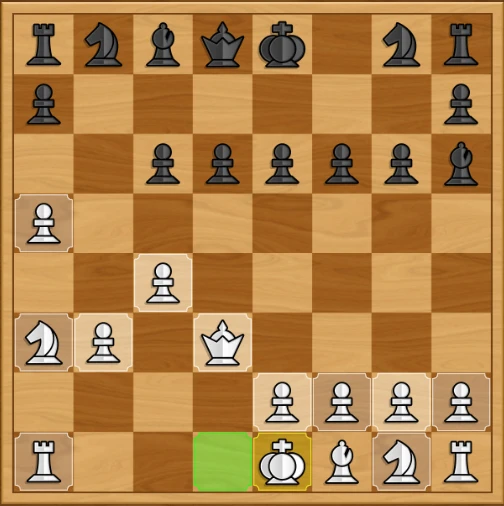
We’ve highlighted the King, but you’ll notice it can only move one space to the left despite the fact that there are no pieces between it and your rook - and neither piece has made a move yet. Unfortunately, if you made the move to the free dark space, it would put your King in line with the opponent’s bishop. As such, you’re in check, so you can’t use the Castling technique here.
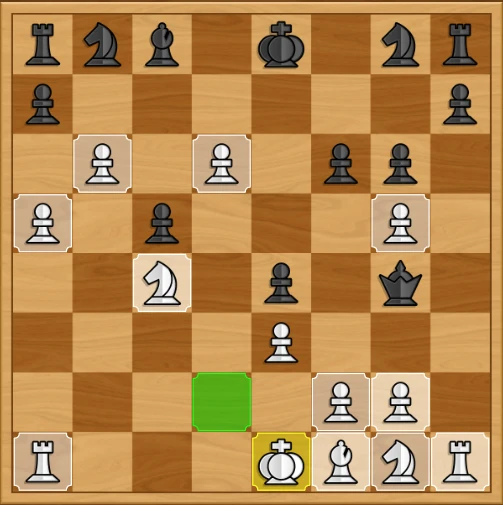
In this situation, you still can’t pull off a castling move despite the fact that your King wouldn’t end up in check. The reason for this is that the King would move across the square to its left, which would’ve put it in the black Queen’s line of site and caused a check. You can’t castle if it means you’re dodging a potential check position from a piece that’s already in place on the board.
Rook’s Role in Chess Games & Strategies To Try
The rook is a valuable piece in chess games and has many offensive and defensive roles. Players will use the mobility of rooks to defend their back ranks and protect their kings. Castling also comes across as a highly beneficial defensive maneuver, though rooks are especially known for the following:
- Controlling Specific Rows & Columns - The rook’s movement makes it excellent at controlling different columns or rows and limiting your opponent’s movements. If you have a rook in one place, it stops your opponent from moving valuable pieces to the same column or row, lest they risk you removing it from the board. You force them to move other pieces and limit their ability to attack.
- Helping You Promote Your Prawns - Many players adopt the strategy of using rooks to protect pawns in the hope of pawn promotion. This is the third special chess move and involves getting your pawn to the back of the board and turning it into a Queen. Use your rook to cut off lines of attack and free up space for your pawn to move ahead one square at a time slowly. It’s an excellent piece to remove other pawns standing in your pawn’s way.
- Closing In On A Checkmate - Finally, you should hold onto your rooks until the endgame, as they’re useful in checkmating your opponent. Rooks are known for “back rank checkmates,” which is why you trap your opponent’s King on their back line and get a rook in line with it. The King can’t move forwards because either its own pieces block it, or you have another piece preventing the move. It’s super powerful - and you can also use two rooks to cut off a King’s escape elsewhere on the board.
Test Your New Rook Knowledge Today
Have you learned some new things about rooks and how they work in chess? Test your newfound knowledge with some games at 247Chess today. Play opponents from around the world, battle against a computer, or play with your friend using the pass-and-play mode.
Seasonal Chess Games
More Games
Chess News
Disclaimer
DISCLAIMER: The games on this website are using PLAY (fake) money. No payouts will be awarded, there are no "winnings", as all games represented by 247 Games LLC are free to play. Play strictly for fun.

































